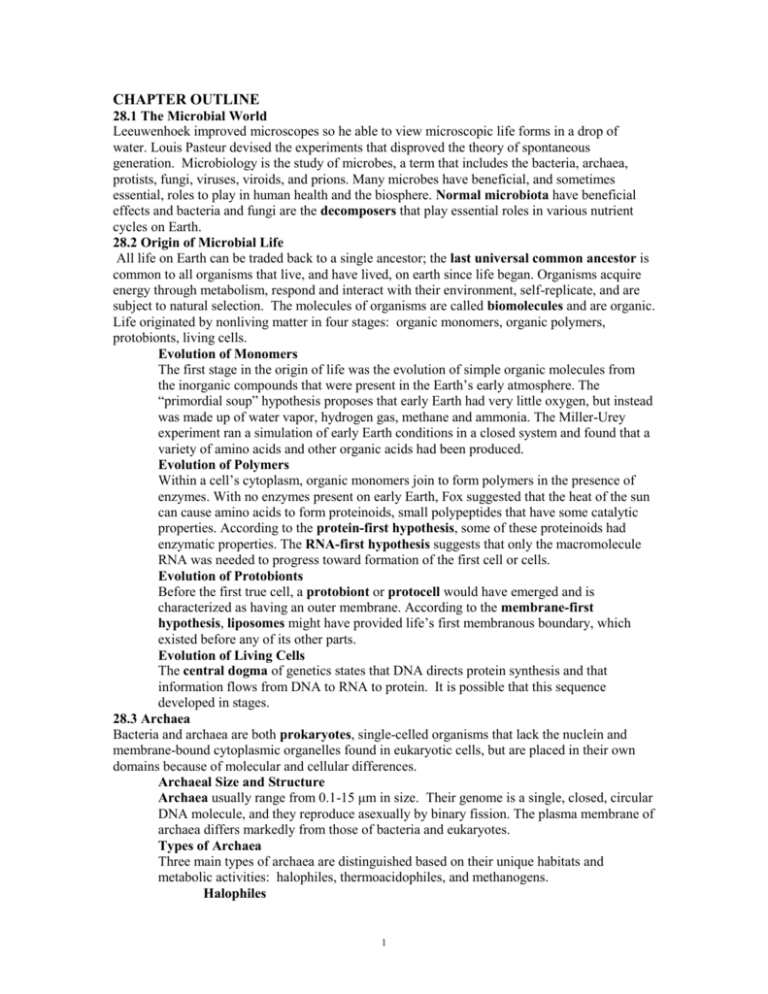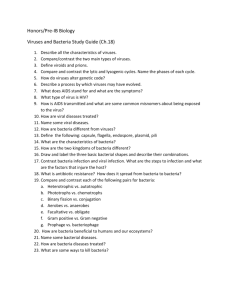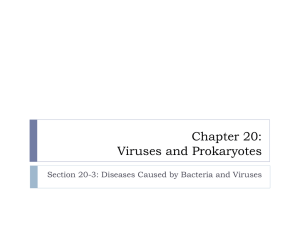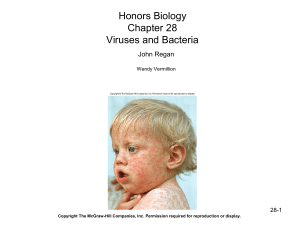CHAPTER OUTLINE
advertisement

CHAPTER OUTLINE 28.1 The Microbial World Leeuwenhoek improved microscopes so he able to view microscopic life forms in a drop of water. Louis Pasteur devised the experiments that disproved the theory of spontaneous generation. Microbiology is the study of microbes, a term that includes the bacteria, archaea, protists, fungi, viruses, viroids, and prions. Many microbes have beneficial, and sometimes essential, roles to play in human health and the biosphere. Normal microbiota have beneficial effects and bacteria and fungi are the decomposers that play essential roles in various nutrient cycles on Earth. 28.2 Origin of Microbial Life All life on Earth can be traded back to a single ancestor; the last universal common ancestor is common to all organisms that live, and have lived, on earth since life began. Organisms acquire energy through metabolism, respond and interact with their environment, self-replicate, and are subject to natural selection. The molecules of organisms are called biomolecules and are organic. Life originated by nonliving matter in four stages: organic monomers, organic polymers, protobionts, living cells. Evolution of Monomers The first stage in the origin of life was the evolution of simple organic molecules from the inorganic compounds that were present in the Earth’s early atmosphere. The “primordial soup” hypothesis proposes that early Earth had very little oxygen, but instead was made up of water vapor, hydrogen gas, methane and ammonia. The Miller-Urey experiment ran a simulation of early Earth conditions in a closed system and found that a variety of amino acids and other organic acids had been produced. Evolution of Polymers Within a cell’s cytoplasm, organic monomers join to form polymers in the presence of enzymes. With no enzymes present on early Earth, Fox suggested that the heat of the sun can cause amino acids to form proteinoids, small polypeptides that have some catalytic properties. According to the protein-first hypothesis, some of these proteinoids had enzymatic properties. The RNA-first hypothesis suggests that only the macromolecule RNA was needed to progress toward formation of the first cell or cells. Evolution of Protobionts Before the first true cell, a protobiont or protocell would have emerged and is characterized as having an outer membrane. According to the membrane-first hypothesis, liposomes might have provided life’s first membranous boundary, which existed before any of its other parts. Evolution of Living Cells The central dogma of genetics states that DNA directs protein synthesis and that information flows from DNA to RNA to protein. It is possible that this sequence developed in stages. 28.3 Archaea Bacteria and archaea are both prokaryotes, single-celled organisms that lack the nuclein and membrane-bound cytoplasmic organelles found in eukaryotic cells, but are placed in their own domains because of molecular and cellular differences. Archaeal Size and Structure Archaea usually range from 0.1-15 μm in size. Their genome is a single, closed, circular DNA molecule, and they reproduce asexually by binary fission. The plasma membrane of archaea differs markedly from those of bacteria and eukaryotes. Types of Archaea Three main types of archaea are distinguished based on their unique habitats and metabolic activities: halophiles, thermoacidophiles, and methanogens. Halophiles 1 The halophiles are salt lovers and have evolved a number of mechanisms enabling them to survive in very salty environments. Some perform a type of photosynthesis. Thermoacidophiles The thermoacidophiles are usually isolated from extremely hot, acidic, aquatic environments such as hot springs, geysers, and underwater volcanoes. Methanogens The methanogens, methane-makers, mostly use carbon dioxide and hydrogen as energy sources, producing methane as a by-product. 28.4 Bacteria Bacteria are the most common type of prokaryote on Earth. Bacterial Size and Structure Most bacteria are between 0.2–10 μm in size, but a few are quite large. Bacteria have three basic shapes: rod, spherical, and spiral. All bacterial cells have a plasma membrane and most have a cell wall. Bacteria can be classified by differences in their cells walls, which are detected using a Gram stain. Most bacteria have a single circular chromosome located in the nucleoid region. Bacterial Reproduction and Gene Transfer Bacteria reproduce asexually by binary fission. They can transfer genes by conjugation, transformation, and transduction. Bacterial Metabolism Bacteria demonstrate a remarkable range of metabolic abilities. Most are heterotrophs, some are chemoautotrophs, and some photosynthesize. Bacterial Diseases in Humans Most types of bacteria do not cause disease, but a significant number do. Pathogenic microbes often carry genes that code for specific virulence factors that determine the type and extent of illness they are capable of causing. Streptococcal Infections More different types of human disease are caused by bacteria from the genus Streptococcus than by any other type of bacterium. Streptococcus bacteria cause pneumonia, meningitis, middle ear infections, tooth decay, the formation of dental caries, strep throat, mild skin diseases, Scarlet fever, rheumatic fever, and necrotizing fasciitis. Staphylococcus aureus and MRSA A strain of Staphylococcus aureus that is resistant to methicillin, called MRSA, is killing an increasing number of young, otherwise healthy individuals. Tuberculosis Tuberculosis is one of the leading worldwide causes of death due to infectious disease. It is chronic disease caused by Mycobacterium tuberculosis, a very slow growing organism. An immune response results in inflammation of the lungs. Food Poisoning Two basic types of bacteria cause food poisoning: those that produce toxins while they are growing in food, and those that cause infections once they are in the intestine. The symptoms are mainly vomiting and diarrhea, they tend to appear suddenly within a few hours of ingestion and are usually self-limiting. Drug Control of Bacterial Diseases Antibiotics kill or inhibit bacteria by interfering with their unique metabolic pathways. Growing resistance of bacteria to antibiotics has become a significant problem. 28.5 Viruses, Viroids, and Prions 2 Viruses are not composed of cells. They are obligate parasites, meaning that they can reproduce only inside a living cell by utilizing that cell’s machinery. Viroids are strands of RNA that can reproduce inside a cell, and prions are protein molecules that cause other proteins to become prions. Viral Size and Structure Most viruses are much smaller than bacteria. They come in a variety of shapes. A virus always has at least two parts—a capsid composed of protein subunits, which protects an inner core of either DNA or RNA. In some viruses, the capsid is surrounded by a membrane called an envelope. Viral Reproduction Viruses infect almost every type of organism on earth and can be host-specific. The life cycle of a typical enveloped animal RNA virus has six steps: attachment, entry, replication, biosynthesis, assembly, and budding. Latency Some animal viruses can become latent (hidden) inside the host cell. Retroviruses have a genome of RNA, but are able to convert their genome into DNA because they contain an enzyme called reverse transcriptase, it can then be integrated into the host DNA. Viral Diseases in Humans Viruses cause many important human diseases. The best protection against most viral diseases is immunization utilizing a vaccine. The Common Cold and Influenza Colds are most commonly caused by rhinoviruses, and the symptoms usually include a runny nose, mild fever, and fatigue. The flu is caused by the influenza virus and is characterized by more severe symptoms. The influenza virus can change rapidly via antigenic drift and antigenic shift. Measles Measles is one of the most contagious human diseases. The fatality rate is higher in less-developed countries than in more-developed ones, but is decreasing due to vaccinations. Herpesviruses Herpesviruses cause chronic infections that remain latent for much of the time. These include cold sores and fever blisters, chickenpox, and infectious mononucleosis. Antiviral Drugs Because viruses use the machinery of host cells for viral replication, it is difficult to develop drugs that affect viral replication without harming host cells. Antibiotics are not effective against viral infections. Viroids and Prions Viroids and prions are also acellular pathogens. A viroid consists of a circular piece of naked RNA. Viroid replication causes diseases in plants, the only known hosts. Prions are proteinaceous infectious particles that cause degenerative diseases of the nervous system in humans and other animals. These diseases include scrapie, mad cow disease, which can infect humans as variant Creutzfeldt-Jakob disease, and chronic wasting disease. 3










